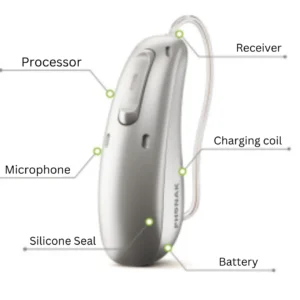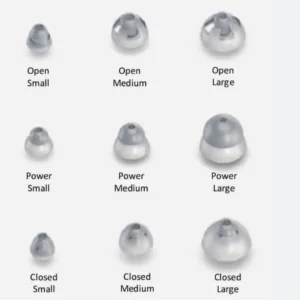From Battery to Earpiece: Understanding the Various Parts of a Hearing Aid
Knowing the ins and outs of your hearing aid isn’t just about technical knowledge; it’s about empowering yourself to make the most of your device. Understanding each component can help you communicate more effectively with audiologists, make informed decisions about adjustments, and troubleshoot minor issues. Let’s take a closer look at how each part plays a pivotal role in enhancing your hearing experience.
The Journey of Sound: From the Environment to Your Ears
Hearing aids work by capturing sound from the environment through a microphone, which then converts these sound waves into digital signals. Inside the hearing aid, a processor analyzes these signals and adjusts them based on the user’s hearing loss profile, which is determined by an audiologist. The processed sounds are then amplified and sent to the speaker, where they are converted back into sound waves and directed into the ear canal through a custom-fitted earmold or dome. This process enhances the user’s ability to hear and understand speech while also amplifying other sounds in the environment. Modern hearing aids are highly sophisticated devices that can differentiate between types of sounds, such as speech versus noise, and can be adjusted to optimize hearing in a variety of settings, offering individuals with hearing loss a greatly improved quality of life.
Find a great audiologist near me.

All About Each Part of the Hearing Aid
The magic of a hearing aid unfolds as it transforms ambient sound into clear, understandable audio. Let’s dive into each part and uncover their roles in this amazing process.
Microphones: Your Ears’ First Responders
- Catching Sound Waves: The journey begins when sound waves hit the hearing aid’s microphone. It’s like the ear’s front door, always open.
- Smart Selection: These aren’t your average microphones. They’re smart, distinguishing chatter from chaos to keep what matters.
- Directional vs. Omnidirectional: Some microphones focus forward, honing in on the person you’re talking to. Others gather sound from all around, keeping you in tune with your surroundings.
- Blending Sounds: Imagine a DJ mixing tracks. These microphones blend sounds for an experience that feels just right.
Amplifier: The Power-Up Phase
- Boosting Signals: Once sounds are captured, the amplifier steps in like a personal trainer for sound, making them stronger.
- Tailored to You: It’s not one-size-fits-all. The amplifier adjusts based on your hearing test results, ensuring comfort and clarity.
- Fine-Tuning: The amplifier knows that too soft is missed and too loud is uncomfortable. It finds the sweet spot.
Processor (Digital Aids): The Brain Behind the Operation
- Crafting Perfect Sound: The processor is like a sound chef, carefully seasoning your audio meal to taste just right.
- Cutting Noise: It reduces noise, making sure you hear more of what you want and less of what you don’t.
- Feedback Suppression: Feedback is that annoying whistle. The processor smartly eliminates it, ensuring a smooth listening experience.
- Customized for You: Imagine a suit tailored to fit you. The processor customizes sound, making it perfect for your ears.
Speaker (Receiver): Delivering the Message
- Turning Signals into Sound: The speaker converts those electrical signals back into sound waves. It’s like translating a foreign language into your native tongue.
- Calibrated for Naturalness: The speaker ensures voices sound natural, not robotic. It’s all about making conversations enjoyable.
- Easing Listening Effort: It works hard so you don’t have to, making understanding speech easier and listening less tiring.
In this carefully orchestrated process, each part of the hearing aid plays a crucial role, working in harmony to enhance your hearing experience. From capturing to delivering sound, the journey is complex, but the result is simple: clear, understandable, and comfortable hearing for you.
Power Source: The Heartbeat of Your Hearing Aid
A hearing aid’s power source is critical to its function. Options include disposable zinc-air batteries and rechargeable lithium-ion batteries. Your choice affects not just the device’s size and weight but also its convenience and maintenance needs.

Customizing Your Hearing Aid
Modern hearing aids provide various options for customization:
- Ear Hook: Found on BTE devices, it secures the hearing aid in place.
- Wax Guards and Domes: These protect against earwax buildup and help the hearing aid fit securely, enhancing sound quality.
- Vents and Earmolds: Vents prevent a plugged-up feeling, while earmolds offer a custom fit for those with severe hearing loss or unique ear shapes.
- Telecoil: This feature connects hearing aids to public address systems and phones, offering clearer sound in public spaces.
Explore more about how telecoils can help you hear better.
While audiologists set the core parts of a hearing aid to match your hearing profile, some aids include user-adjustable features. These include volume control, program settings for different environments, and focus mode for better clarity in noisy situations.
Tinnitus Masking Features
Some digital hearing aids include built-in tinnitus maskers. These innovative features produce soothing sounds, such as white noise or soft music, to distract your brain from the ringing in your ears. By filling the silence that often makes tinnitus more noticeable, these sounds can help reduce the perception of tinnitus, making it less intrusive.
Are the Parts of Your Hearing Aid Working for You?
A deep dive into the parts of a hearing aid reveals the sophistication behind these compact devices designed to improve your quality of life. By understanding how each component contributes to sound processing and delivery, you become a more informed and proactive participant in your hearing health. For personalized guidance and to explore the possibilities of your hearing aid, contact Stanford Hearing, where experts are ready to optimize your hearing experience.
